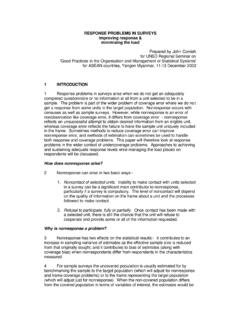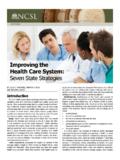Transcription of Promoting Healthy Eating and Physical Activity for a ...
1 Promoting Healthy Eating AND Physical Activity FOR A HEALTHIER NATION TABLE OF CONTENTS Introduction Burden of Physical Inactivity and Poor Nutrition Overall Magnitude Economic and Social Costs Disparities Related Healthy People 2010 Objectives Prevention Opportunities Levels of Prevention Socioecological Approach Essential Strategies Interventions State and Local Infrastructure Program Management and Administration Surveillance and Evaluation Partnerships State Plans Policy Communications Professional Development Funding National Leadership and Partnerships Progress to Date and Challenges Ahead Web-Based Resources Public Health Policy Surveillance, Evaluation, and Research Interventions and Program Development Communication and Social Marketing Partnerships, Alliances, and Coalitions References 7 1 7 Promoting Healthy Eating AND Physical Activity FOR A HEALTHIER NATION Carol A. Macera, PhD, and staff of the Division of Nutrition and Physical Activity National Center for Chronic Disease Prevention and Health Promotion Introduction This chapter provides a framework for a comprehensive program to address the problems of poor nutrition and Physical inactivity on a state or community level.
2 while this framework is broader than any program that would be funded by CDC, it is designed to give state and local guidance in establishing a coordinated, comprehensive nutrition and Physical Activity program and soliciting a broad coalition of stakeholders and partners. State public health authorities are in a unique position to strengthen and coordinate efforts to improve nutrition and Physical Activity among Americans. Burden of Physical Inactivity and Poor Nutrition Overall Magnitude The importance of proper nutrition and Physical Activity in reducing rates of disease and death from chronic diseases has been well Poor diet and Physical inactivity cause 310,000 to 580,000 deaths per year and are major contributors to disabilities that result from diabetes, osteoporosis, obesity, and stroke. The results of one study showed that 14% of all deaths in 1990 could be attributed to poor diet and Activity patterns,1 and another study linked sedentary lifestyles to 23% of chronic disease-related deaths in the United States in According to Healthy People 2010,4 about 75% of Americans do not eat enough fruit, more than half do not eat enough vegetables, and 64% consume too much saturated fat.
3 The diets of many population subgroups contain too much total fat, saturated fat, Centers for Disease Control and Prevention and calories but not enough of other important elements such as calcium. Low fruit and vegetable consumption and high saturated fat intake are associated with coronary heart disease, some cancers, and Breast milk is acknowledged to be the most complete source of nutrition for infants and offers many benefits for mothers and babies. According to the Department of Health and Human Services Blueprint for Action on Breastfeeding, breastfeeding reduces the incidence or severity of childhood infections and chronic diseases such as type 1 and 2 diabetes, asthma, and childhood Additional evidence suggests that breastfeeding may help prevent childhood Despite recognition by the American Academy of Pediatrics that breastfeeding is the ideal method of infant feeding,9 only 64% of all mothers in the United States initiate breastfeeding, and only 29% continue to breastfeed their infants for 6 months after Regular Physical Activity is essential for a Healthy Physically inactive people are almost twice as likely to develop coronary heart disease as people who engage in regular Physical Thus Physical inactivity poses almost as much risk for heart disease as cigarette smoking, high blood pressure, or a high cholesterol level.
4 But is more prevalent than any of these other risk People with other risk factors for coronary heart disease, such as obesity and hypertension, may particularly benefit from Physical It also 7 2 Promoting Healthy Eating AND Physical Activity FOR A HEALTHIER NATION helps older adults remain independent and enhances the quality of life for people of all ages. Obesity or overweight status is defined by body mass index (BMI), which is derived by dividing weight in kilograms by the square of height in meters. From 1991-2000, the prevalence of obesity (defined as BMI > 30 k/m2) among adults increased nationally, in every state, and in all segments of the Obesity leads to numerous health problems, including hypertension, dyslipidemia, type 2 diabetes, coronary heart disease, stroke, gall bladder disease, osteoarthritis, sleep apnea, respiratory problems, and some cancers ( , endometrial, breast, prostate, and colon cancers). Because obesity is a risk factor for several chronic diseases, the economic and social consequences of this obesity epidemic could be while many factors have contributed to the obesity epidemic, prevention efforts should focus on helping people reduce their calorie intake and increase their Physical Activity .
5 The prevalence of obesity is increasing more rapidly among children than among adults. Because a growing body of evidence suggests that breastfeeding offers protection against excessive weight gain in childhood and adolescence,8 CDC advocates breastfeeding as a reasonable strategy for reducing children s risk of becoming overweight. Economic and Social Costs The economic burden of poor diet, Physical inactivity, and obesity is substantial. All are significant risk factors for developing coronary heart disease, certain types of cancer, stroke, and diabetes, conditions that involve considerable medical expense as well as lost work time, disability, and premature death. In one study, the direct medical cost for diet-related manifestations of these four conditions was estimated at $ billion (in 1995 dollars) and the total cost, including lost productivity because of illness and premature death, was estimated to be $ In another study based on 1987 medical expenditure data, researchers estimated that if the more than 88 million inactive Americans over the age of 15 began engaging in regular moderate Physical Activity , annual national medical costs could be reduced by as much as $ billion in 2000 The medical costs associated with obesity are even higher.
6 An estimated $100 billion annually based on 1995 Taken together, inactivity and obesity accounted for of the 1995 health care expenditures in the United In addition to these economic costs, immeasurable costs due to social and emotional problems, both for those affected and for their friends and families, may result from inactivity- and obesity-related Disparities The problems associated with poor diet, Physical inactivity, and obesity affect most population segments; however, there are marked disparities in the impact that these problems have on various groups of people, particularly by race/ethnicity and by education level. Data from Healthy People 2010 4 indicate that Physical inactivity, vegetable intake, breastfeeding, and weight status vary by race/ ethnicity, gender, educational level, and age (Table 1). Related Healthy People 2010 Objectives Healthy People 2010 4 contains 19 objectives directly related to nutrition and breastfeeding and 15 directly related to Physical Activity .
7 However, because poor nutrition and Physical inactivity are associated with increased risk for many health problems, they are also mentioned in almost every other priority area. In fact, Physical Activity and overweight/obesity are 2 of the 10 Leading Health Indicators listed in Healthy People 2010 as major health concerns in the United The full text of Healthy People 2010 can be found at Prevention Opportunities Levels of Prevention Because poor dietary habits and Physical inactivity are associated with many adverse health outcomes, most adults and children could benefit from interventions designed to improve their Eating habits and increase their Activity levels. Such intervention programs fall into three general categories: health promotion, primary prevention, and secondary 7 3 CHRONIC DISEASE PREVENTION AND CONTROL Table 1. Percentages of Adults in Various Physical Activity or Nutritional Categories, Overall and by Select Sociodemographic Characteristics Consumption No leisure of 3 or more Breastfeeding time servings of newborn Physical vegetables infant for Obese Activity , per day,* 6 months, (BMI > 30), 1997 1994 96 1998 1999 2000 Overall 40 49 29 31 Race/Ethnicity White Black Hispanic 38 52 54 50 43 47 31 19 28 29 40 34 Gender Men Women 36 43 64 49 28 33 Educational level (among people 25 years of age and older) Less than 9th grade 73 Grades 9 11 59 High school grad 46 Some college or AA 35 College grad 24 23 21 21 40 Family income level < 130% poverty threshold >130% poverty threshold 42 50 Age groups 18 24 years 25 44 years 45 64 years 65 74 years 75 years and older 31 34 42 51 65 *People aged 2 years and older.
8 People aged 20 years and older. People aged 40 59 years. Source: Healthy People 20104 and NHANES 1999 2000. 7 4 Promoting Healthy Eating AND Physical Activity FOR A HEALTHIER NATION prevention. The goal of health promotion is to help people establish an active lifestyle and Healthy Eating habits early in life and to maintain these behaviors throughout their lives. The goal of primary prevention is to help people who have risk factors for chronic disease ( , elevated blood pressure or serum cholesterol levels) prevent or postpone the onset of disease by establishing more active lifestyles and healthier Eating habits. The goals of secondary prevention are to help people who already have a chronic disease cope with and control these conditions and to prevent additional disability by increasing their Physical Activity and establishing more healthful Eating patterns. Socioecological Approach To be most effective in the long run, public health programs should focus on health promotion as well as disease prevention.
9 For example, by Promoting breastfeeding to pregnant women and new mothers and supporting their efforts to breastfeed, public health organizations can help children develop Healthy Eating habits during infancy. Because appropriate Physical Activity levels and Healthy Eating behaviors should be instilled in childhood and maintained throughout life, prevention efforts that target older children and schools are equally important, as are interventions for adults who are inactive or have poor dietary habits even though they have not yet developed chronic diseases. All interventions should be appropriate to the target audience, and different strategies may be required to reach different segments of the population. Interventions may address individuals, institutions, communities, policies, or the environment and can be effectively implemented in various settings, such as schools, work sites, health care facilities, and places of worship. Whatever population segment is targeted by an intervention, its members are also influenced by a social network consisting of family members, friends, colleagues, and acquaintances.
10 Interventions have the best chance of succeeding if they are directed at all elements of this network , 21 Increasingly, health promotion professionals are recognizing the dynamic interplay between individuals and their environments. Although lifestyle choices are ultimately personal decisions, they are made within a complex mix of social and environmental influences that can make healthier choices either more or less accessible, affordable, comfortable, and Research has shown that behavior change is more likely to endure when a person s environment is simultaneously changed in a manner that supports the behavioral , 26 Therefore, interventions should address not only the intentions and skills of individuals, but also their social and Physical environments, including the social networks and organizations that affect Essential Strategies Guidelines for Comprehensive Programs to Promote Healthy Eating and Physical Activity ( ) is a document designed to help state and local health advocates create comprehensive nutrition, Physical Activity , and obesity control These guidelines provide recommendations in seven major areas.














